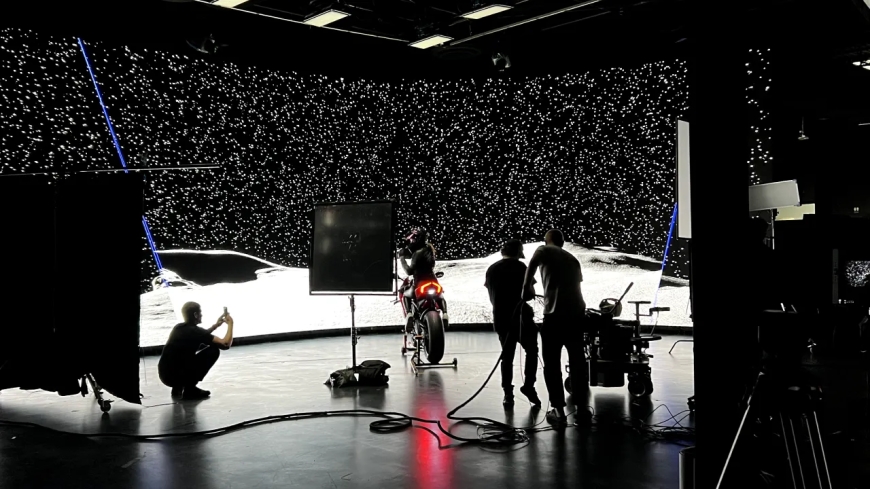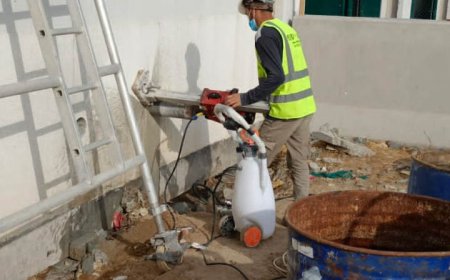Exploring the Future of Immersive Technology with Virtual Caves
In the rapidly evolving landscape of immersive technology, Virtual Cave systems, also known as Cave Automatic Virtual Environments (CAVEs), are redefining how we interact with digital worlds. Unlike traditional virtual reality (VR) headsets, which offer individual, often isolating experiences, Virtual Caves provide room-sized, collaborative, and highly immersive environments that allow multiple users to engage with 3D digital content naturally. From education and architecture to entertainment and scientific research, Virtual Caves are transforming industries by offering unparalleled freedom of movement, high-resolution visuals, and collaborative potential. At the forefront of this revolution is ARwall, a leading innovator in extended reality (XR) and virtual production, delivering cutting-edge solutions that push the boundaries of what Virtual Caves can achieve. ARwall.co

In the rapidly evolving landscape of immersive technology, Virtual Cave systems, also known as Cave Automatic Virtual Environments (CAVEs), are redefining how we interact with digital worlds. Unlike traditional virtual reality (VR) headsets, which offer individual, often isolating experiences, Virtual Caves provide room-sized, collaborative, and highly immersive environments that allow multiple users to engage with 3D digital content naturally. From education and architecture to entertainment and scientific research, Virtual Caves are transforming industries by offering unparalleled freedom of movement, high-resolution visuals, and collaborative potential. At the forefront of this revolution is ARwall, a leading innovator in extended reality (XR) and virtual production, delivering cutting-edge solutions that push the boundaries of what Virtual Caves can achieve. ARwall.co
What is a Virtual Cave?
A Virtual Cave, or CAVE, is a room-sized immersive environment where high-resolution 3D images are projected onto walls, floors, and ceilings, creating a fully enveloping digital world. Originally developed in 1992 by researchers at the University of Illinois at Chicago, CAVEs were designed to overcome the limitations of early head-mounted displays (HMDs) by offering a shared, headset-free experience. Users wear lightweight stereoscopic glasses and are tracked by motion sensors, allowing the system to adjust visuals in real-time to match their perspective. This creates a seamless, natural interaction with the virtual environment, free from the constraints of bulky headsets or limited play areas.
Unlike traditional VR setups, Virtual Caves prioritize collaboration and scale. Multiple users can occupy the same space, seeing and interacting with each other and the virtual content in real time. The result is a sense of presence and immersion that feels authentic, with high-resolution projections delivering visuals that surpass the capabilities of most consumer VR headsets. Audio systems further enhance the experience by providing spatial soundscapes that match the visuals, making users feel as though they are truly inside the digital world.
The Advantages of Virtual Caves Over Traditional VR
While VR headsets have gained popularity for their accessibility and affordability, Virtual Caves offer distinct advantages that make them ideal for professional and collaborative applications:
-
Freedom of Movement: Unlike VR headsets, which often restrict users to small play areas due to tracking limitations, Virtual Caves allow natural walking and interaction within a room-sized space. This eliminates the need for controllers or tethered systems, providing a more intuitive experience.
-
Collaborative Potential: Virtual Caves enable multiple users to share the same virtual environment simultaneously, fostering teamwork and interaction. This is particularly valuable in fields like architecture, engineering, and construction (AEC), where stakeholders can collaboratively review 3D models at a human scale.
-
Comfort and Accessibility: Prolonged use of VR headsets can cause motion sickness, eye strain, or discomfort. Virtual Caves eliminate these issues by relying on natural vision and lightweight stereoscopic glasses, making them suitable for extended sessions.
-
Superior Visual Quality: With large-scale projection surfaces or LED displays, Virtual Caves deliver high-resolution visuals that capture fine details and create a more authentic sense of scale. This is particularly important for applications like data visualization or product design, where precision is critical.
-
Customizable Configurations: Virtual Caves can be tailored to specific needs, with options ranging from two-wall setups to fully enclosed six-sided environments. Companies like ARwall specialize in creating bespoke solutions that integrate seamlessly with existing workflows.
ARwall: Pioneering the Future of Virtual Caves
As a leader in XR and virtual production, ARwall is at the cutting edge of Virtual Cave technology, offering innovative solutions that empower creators, educators, and professionals to bring their visions to life. With a multidisciplinary team from TV, VFX, design, mobile, games, and advertising, ARwall combines technical expertise with creative ingenuity to deliver plug-and-play solutions for immersive environments. Their work in virtual production, LED stage management, and AR/VR set extensions has made them a top choice for industries seeking to harness the power of Virtual Caves.
ARwalls proprietary tools simplify the creation and management of Virtual Cave systems, making them accessible to filmmakers, educators, and businesses alike. Their ARFX Pro Plugin and ARFX Launcher enable seamless integration of real-time rendering, virtual lighting, and green screen capabilities, ensuring that users can create immersive environments with ease. By offering turnkey solutions that include hardware, software, and creative consulting, ARwall is democratizing access to advanced immersive technologies, allowing organizations of all sizes to leverage the potential of Virtual Caves.
Applications of Virtual Caves Across Industries
The versatility of Virtual Caves makes them a game-changer across a wide range of sectors. Here are some key applications where Virtual Caves, powered by companies like ARwall, are making a significant impact:
1. Education and Training
Virtual Caves are revolutionizing education by providing immersive learning environments that engage students and professionals in new ways. For example, medical students can use Virtual Caves to practice surgical techniques in a risk-free, collaborative setting, with realistic 3D models of anatomy. Similarly, history students can explore virtual reconstructions of ancient civilizations, walking through digital landscapes as if they were there. ARwalls solutions enhance these experiences by providing high-fidelity visuals and real-time interaction, making learning more engaging and effective.
2. Architecture, Engineering, and Construction (AEC)
In the AEC sector, Virtual Caves enable architects, engineers, and clients to collaborate on 3D models of buildings or infrastructure projects. By stepping into a life-sized virtual model, stakeholders can assess designs, identify potential issues, and make informed decisions before construction begins. ARwalls expertise in virtual set design and real-time rendering ensures that these models are both accurate and visually stunning, streamlining the design review process.
3. Automotive and Product Design
Automotive manufacturers use Virtual Caves to test vehicle designs, analyze driver ergonomics, and simulate driving conditions. By integrating physical elements like seats or steering wheels into the virtual environment, designers can evaluate user experiences with unparalleled realism. ARwalls plug-and-play solutions make it easy to create these hybrid environments, combining physical and virtual elements for maximum impact.
4. Entertainment and Virtual Production
In the entertainment industry, Virtual Caves are transforming virtual production by providing filmmakers with immersive environments for pre-visualization, rehearsals, and shooting. ARwalls technology allows directors to create realistic virtual sets with real-time lighting and camera tracking, reducing production costs and enhancing creative control. Their work with LED walls and AR/VR set extensions has been praised by industry leaders like StudioBinder, showcasing their ability to deliver cinematic-quality experiences.
5. Scientific Research and Data Visualization
For researchers, Virtual Caves offer a powerful tool for visualizing complex datasets in three dimensions. Whether studying molecular structures, astronomical phenomena, or geological formations, scientists can interact with data in ways that reveal new insights. ARwalls high-resolution rendering capabilities ensure that these visualizations are both accurate and visually compelling, making them ideal for collaborative research environments.
6. Cultural and Historical Preservation
Virtual Caves are also being used to preserve and share cultural heritage. For example, the Marble Arch Caves in Northern Ireland offer a VR Cave experience that allows visitors to explore a 340-million-year-old cave system through 360-degree footage and spatial audio. ARwalls expertise in creating immersive storytelling experiences could enhance such projects, making history accessible to a global audience.
Challenges and Future Directions
Despite their many advantages, Virtual Caves face challenges that must be addressed to achieve widespread adoption. The primary obstacle is cost, as building a CAVE requires significant investment in hardware, software, and dedicated space. However, companies like ARwall are working to make Virtual Caves more accessible by offering modular, cost-effective solutions that cater to a variety of budgets.
Another challenge is the need for specialized expertise to design, install, and maintain Virtual Cave systems. ARwall addresses this by providing comprehensive consulting and support services, ensuring that clients can fully leverage their technology without requiring in-house technical expertise.
Looking to the future, advancements in display technology, such as tessellated panel displays and direct-view LED screens, are poised to make Virtual Caves more compact and efficient. These innovations will reduce the space required for installations, making CAVEs viable for smaller venues. Additionally, the integration of haptic devices and full-body tracking will further enhance the realism and interactivity of Virtual Cave experiences.
The Role of ARwall in Shaping the Future
As Virtual Cave technology continues to evolve, ARwall remains a driving force in the industry. Their commitment to innovation is evident in their development of tools like the ARFX Home Studio Complete Kit, which provides a plug-and-play solution for creators looking to build their own immersive environments. By combining cutting-edge hardware with user-friendly software, ARwall is making Virtual Caves accessible to a broader audience, from independent filmmakers to large-scale research institutions.
ARwalls vision extends beyond technology to the creative possibilities of Virtual Caves. By fostering collaboration between artists, engineers, and storytellers, they are creating experiences that resonate on an emotional and intellectual level. Whether its a virtual tour of a historical site, a collaborative design review, or a groundbreaking film production, ARwalls solutions are helping to shape the future of immersive technology.
Conclusion
Virtual Caves represent a bold step forward in the world of immersive technology, offering a collaborative, high-fidelity alternative to traditional VR headsets. With their ability to transform industries like education, architecture, automotive design, entertainment, and scientific research, Virtual Caves are poised to become a cornerstone of the digital age. As a leader in this space, ARwall is paving the way with innovative solutions that make Virtual Caves more accessible, versatile, and impactful. By visiting ARwall.co, you can explore how their expertise in XR and virtual production can bring your ideas to life in a Virtual Cave, creating experiences that inspire, educate, and entertain.




































